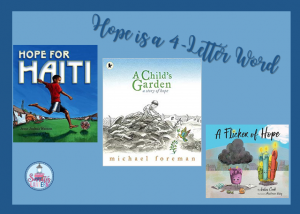
Have you ever felt a sense of hopelessness? Maybe things seem to always go wrong, you trip over your own feet, or get knocked down by a dog at the park and sprain your ankle, or have a fight with your significant other, or get a traffic ticket for speeding. We’ve all been there in one way or another. We have to remember that these things aren’t the end of the world, when you fall you have to get up and know there’s always tomorrow and the sun will shine again. If you haven’t guessed by this introduction, this month, We Teach So Hard’s book selection focuses on HOPE! aaand…What a timely subject in this day and age.
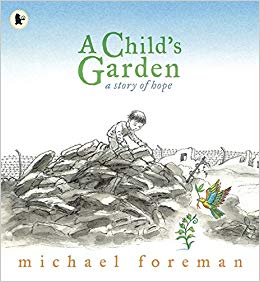 The first book I’ve chosen to share with you is called A Child’s Garden: A Story of Hope by Michael Foreman. A young boy’s home has been reduced to rubble causing his family to struggle for survival. What makes things even worse, a barbed wire fence and soldiers separate him from the meandering streams and hills that he used to wander freely with his father and friends. One day he notices a small bit of green peeping through the ground, reaching toward the sunlight. He silently starts helping it grow by watering and caring for it. When lo and behold, it turns out to be a beautiful grapevine that covers the fence and creates a shady place for children to play.
The first book I’ve chosen to share with you is called A Child’s Garden: A Story of Hope by Michael Foreman. A young boy’s home has been reduced to rubble causing his family to struggle for survival. What makes things even worse, a barbed wire fence and soldiers separate him from the meandering streams and hills that he used to wander freely with his father and friends. One day he notices a small bit of green peeping through the ground, reaching toward the sunlight. He silently starts helping it grow by watering and caring for it. When lo and behold, it turns out to be a beautiful grapevine that covers the fence and creates a shady place for children to play.
As fate would have it, in this war torn country, soldiers chop down the vine, but the seeds have already been sown on the other side, and the plant starts to grow with a little girl’s tender care. The vine becomes so strong and that its branches spread to the boy’s side and entwine to become even more magnificent. Again there is shade for the children to play beneath.
Metaphorically, the plant represents hope for the future that one day the fence will disappear and the boy will wander by the streams and hills of his beloved country once more. The creative illustrations are done in black and white, while the vine is in color, a clever way to get the author’s positive point across.
Many of us get upset when things don’t go our way, however, there’s always someone less unfortunate than us. This book definitely brings this theme home. Looking at the devastation we see almost every day, wrought by war, a lack of understanding, and empathy for each other saddens me. If we have nothing else, we have hope that in the future, this will all change.
The activity you can use, isn’t for the faint of heart since you’re going to turn your room upside down. So roll up your sleeves and get ready. Your kids are going to locate their desks. Before they come in, pile things up near the door, place the desks in such a manner, that the kids will have to step over them, turn chairs upside down, throw papers around, etc. The messier the better.
Wait outside the door to prepare your students for the activity.
- Tell them that a disaster struck the classroom last night, they have to find their desk and then put everything back the way it should be.
- Have them think about the emotions they’re feeling while they walk around stepping over rubble, looking for their desks and fixing up the room.
Now ask the following questions:
- What did they think/feel when teacher told them what they were to do?
- How did they feel when they couldn’t walk around or find their desk?
- How did they feel about being in such a messy room? How did they feel when they had to clean up the room?
- Show the book cover and let the kids predict what the story is about.
After listening to their answers let them know that the book is about a young boy who lives in a war torn country, but no matter how bad his situation is, he still feels hopeful for his future.
Once you’ve finished the story, help them to understand that the emotions they felt when they first went into the classroom were similar to those that the boy was feeling.
- Discuss similarities and differences.
- Talk about the illustrated or written metaphors that were symbols of hope.
- Ask them why most of the illustrations are in black/white, while only a few things are in color. let them know that the author did this for a reason. Have them tell you the reason.
- Do they know of any other stories that are part black/white, part color.
- Have students make silhouette drawings based on scenes from the book where the metaphors of hope stand out. They should be able to describe what symbol the image represents. Finally, write some metaphors depicting hope.
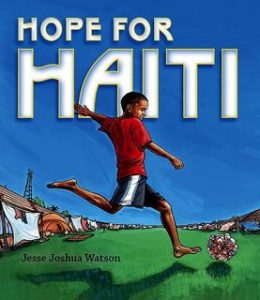 The title of the second book I’ve chosen is called Hope for Haiti by Joshua Watson, a must read aloud for your students. One dark day, the earth shook so hard that a young boy’s entire village was devastated, forcing his family to live in a soccer stadium whose only shelter was an old sheet held up by some tin. Food and water were scarce so they were forced to wait in long lines to receive them. To help them forget about their pain, if even for a short while, the children would play soccer with a ball made from rags. Getting caught up in the love of the game they’d leave their bare surroundings and enter into a world filled with many possibilities.
The title of the second book I’ve chosen is called Hope for Haiti by Joshua Watson, a must read aloud for your students. One dark day, the earth shook so hard that a young boy’s entire village was devastated, forcing his family to live in a soccer stadium whose only shelter was an old sheet held up by some tin. Food and water were scarce so they were forced to wait in long lines to receive them. To help them forget about their pain, if even for a short while, the children would play soccer with a ball made from rags. Getting caught up in the love of the game they’d leave their bare surroundings and enter into a world filled with many possibilities.
The soccer ball, a metaphor for hope, inspires a strong connection between a grief stricken country’s former life and it’s future. This wonderful author has produced an inspirational tribute to the fortitude of the people of Haiti and the hopes of their children.
Before reading the book, discuss earthquakes.
- Have them close their eyes and imagine what an earthquake must feel like.
- Find out how they’d feel if they lived in a place that was devastated by an earthquake and their entire neighborhood was in ruin, including their home.
- Show them the book cover and have them make predictions as to what will happen in the story, and write them on paper.
- After reading, find out if their predictions were correct.
- Talk about what occurred, and what made the children hopeful. Lead them to realize, that even in the darkest of times, there is help and hope for the future.
- Come up with some ideas about how you could help the people of Haiti, many of whom are still suffering. Choose one thing that your class could do and follow through with it.
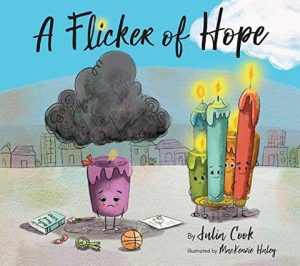 My final book is A Flicker of Hope by Julia Cook. It’s a story that is near and dear to her heart, about a little candle who has a tiny flame that is almost out. It helps us understand that everyone has mountains to climb, rivers to cross, and/or dark clouds that surround us, but we are resilient and can overcome them. When one feels hopeless, he/she isn’t alone, there are people who can help, ways to ask for help, and opportunities for one to help others build hope. This little treasure has beautiful illustrations and sentiment.
My final book is A Flicker of Hope by Julia Cook. It’s a story that is near and dear to her heart, about a little candle who has a tiny flame that is almost out. It helps us understand that everyone has mountains to climb, rivers to cross, and/or dark clouds that surround us, but we are resilient and can overcome them. When one feels hopeless, he/she isn’t alone, there are people who can help, ways to ask for help, and opportunities for one to help others build hope. This little treasure has beautiful illustrations and sentiment.
- Have your class make bookmarks depicting hope.
Remember that we’re a resilient species and even during the darkest of times…There is HOPE! Let’s instill this in our children.
Deann
Be sure to visit Kathie, Retta and Tracy’s blog posts from We Teach So Hard for more inspiring tips and ideas about the many ways to show HOPE. To listen to our podcast on iTunes click HERE or the image below.
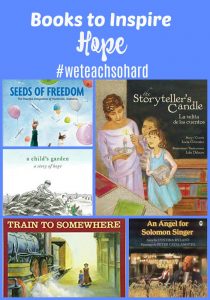
Bringing Hope in Times of Angst // Tried & True Teaching Tools
Hope is a 4-Letter Word // Socrates Lantern
The Thing With Feathers: Books For Teaching Hope //Wild Child’s Mossy Oak Musings
Finding Hope //Rainbow City Learning

A Child’s Garden sounds lovely amidst hard circumstances! I’m sure my students will love Hope for Haiti! These are great choices; my Amazon cart is filling up again! LOL
OOOOOHHHH! A Child’s Garden sounds like a book I need to have. I love the questions you have for us too. I’ve copied them down to use for a Chalk Talk. Thank you!